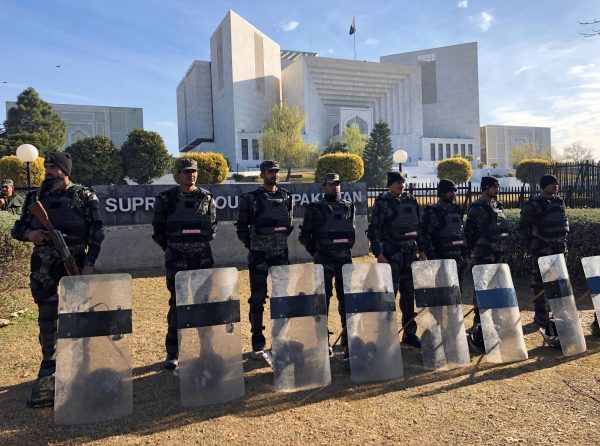In 2018, Pakistan elected Prime Minister Imran Khan. But last year, instead of stabilising his government, the Prime Minister tried to crack the accountability whip on his political opponents. Leaders of both opposition parties, Mian Nawaz Sharif of the Pakistan Muslim League-Nawaz (PML-N) and Asif Ali Zardari of the Pakistan People’s Party were incarcerated alongside several other party leaders. The government arrested a prominent PML-N leader, Rana Sanaullah, under trumped-up charges of narcotics smuggling. This generated strong resentment in Punjab province, the country’s heartland.
But speculation that the displeasure would reverberate on the streets was not realised. People did not even protest the price hikes of basic utilities and food, which indicates the impact of decades of patronage politics that has systematically weakened politics in the country. The second half of last year saw a plummeting economy and rising inflation. But patronage politics deprived people of their capacity to protest and conduct political movements. An exciting exception was the student solidarity march, a disjointed movement of left-leaning students across the country.
Khan tried to bring temporary economic relief by seeking cash from Pakistan’s new benefactor China and traditional partners like the United States. Through the China–Pakistan Economic Corridor (CPEC) agreement signed in 2015, Beijing is expected to invest approximately US$ 61 billion in various projects in the country. However, the investment seems to have slowed after the 2018 change of government in Pakistan due to Islamabad’s hesitation over the cost of various projects. More importantly, Khan’s government wanted China to provide cash. Ultimately, Pakistan’s Prime Minister received conditions-laden relief of US$6 billion from the International Monetary Fund. But the inability to strengthen the economy made the government appear shaky.
Its weakness made it more dependent on the military. Pakistan’s Chief of Army Staff General Qamar Javed Bajwa held meetings with agriculturists and businessmen to convince them to pay taxes and increase exports, indicating a new form of politics where the civilian government is directly controlled by the armed forces.
Last August, Khan’s political dependency on Bajwa became more apparent when he extended the Army Chief’s tenure. The order lacked legality and became highly controversial, resulting in a court case. On 28 November, the Supreme Court ruled to extend Bajwa’s tenure by six months and ordered the Parliament to formulate new rules in the Army Act and the 1973 Constitution for the process.
Ultimately, Bajwa got the three-year extension he desired by successfully manipulating political parties that have weakened due to years of poor political direction. Pakistan’s political parties have weakened to the point where they must negotiate timidly for short-term personal benefits rather than long-term political dividends.
Bajwa’s continuation will further weaken Pakistan’s democratic institutions, as his team have adopted harsh measures to tame the judiciary and media. Restrictions were placed on the media to not air news outside of that recommended by the military’s public relations agency. In early December 2019, a group of militants threatened violence against the main English-language newspaper Dawn. The Army has a history of using militant groups in threatening political opponents with mob violence. These actions indicate that despite fighting several wars against Islamist terrorists, the military has not abandoned its traditional approach of using militants.
In late 2019 even the Taliban surfaced in some of the tribal agencies. From the military’s perspective this may be necessary to convince the Taliban to negotiate with the United States.
In July the Khan–Bajwa team undertook a successful tour of the United States. Despite not securing a promise of needed cash from Washington, the trip helped restart a conversation between the two states. This was certainly an improvement from 2018 when US President Donald Trump angrily tweeted about Pakistan, soliciting a response from Khan.
Bajwa received a 21-gun salute upon his arrival at the Pentagon and was present during most discussions with the US President, indicating Washington’s support of his extended tenure. The two countries have much to negotiate, from US troop withdrawal in Afghanistan to reducing Pakistan’s dependency on China. But 2019 was an interesting year with Pakistan’s hybrid ‘civilian–military’ government trying to balance both its relationships with China and the United States.
Pakistan has also struggled to stay out of the Iran–Saudi Arabia cold war. Close relations with Riyadh stymied the military’s ability to signal its neutrality to Iran despite Khan and Bajwa both visiting Tehran last year.
Relations with India also worsened in 2019, with the terrorist attack in Indian-administered Kashmir killing about 40 paramilitary personnel. India accused Pakistan-based group Jaish-e-Mohammed of the attack and responded by bombing an alleged terrorist training site in Balakot, Pakistan. The military exchange that followed lowered the threshold for conflict on both sides of the border. With Delhi’s hardening stance towards terror attacks, compounded with deepening religious conservatism in India, especially drastic changes in its citizenship laws targeting Muslims, South Asia has become a region to watch for escalation in 2020.
A limited war would not bode well for either India or Pakistan. It would certainly not be good for Pakistan, given that it struggled last year to portray itself as a safe tourist destination. A good network of highways, partly built with Chinese help and money, and aggressive advertisement may help. But much depends on political, economic and social stability — three areas where the country has miles to travel before it can regain confidence.
Ayesha Siddiqa is a Research Associate at the South Asia Institute and the Centre for International Studies and Diplomacy (CISD), SOAS University of London.
This article is part of an EAF special feature series on 2019 in review and the year ahead.

